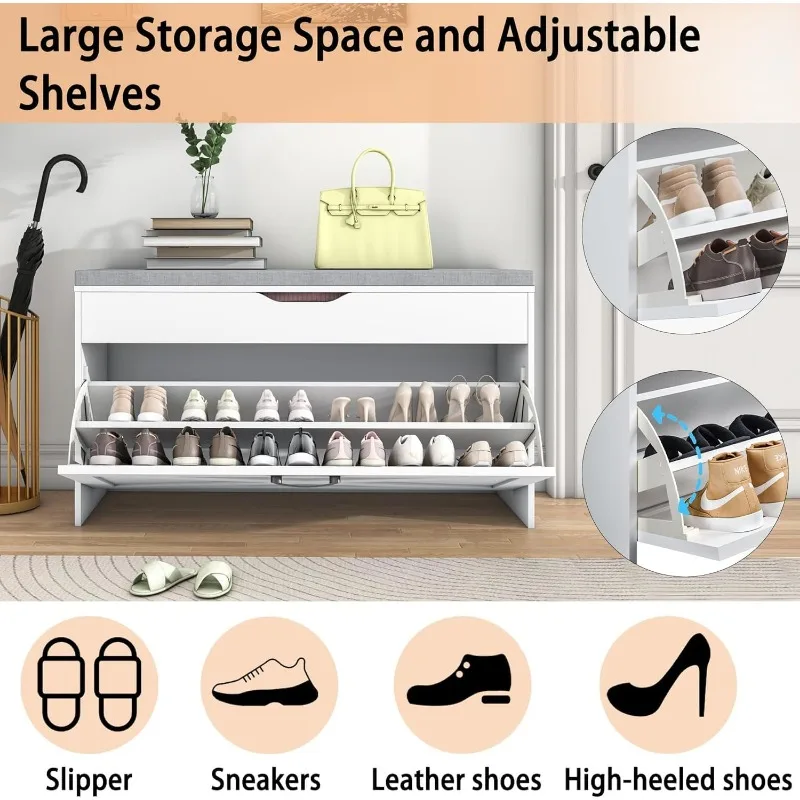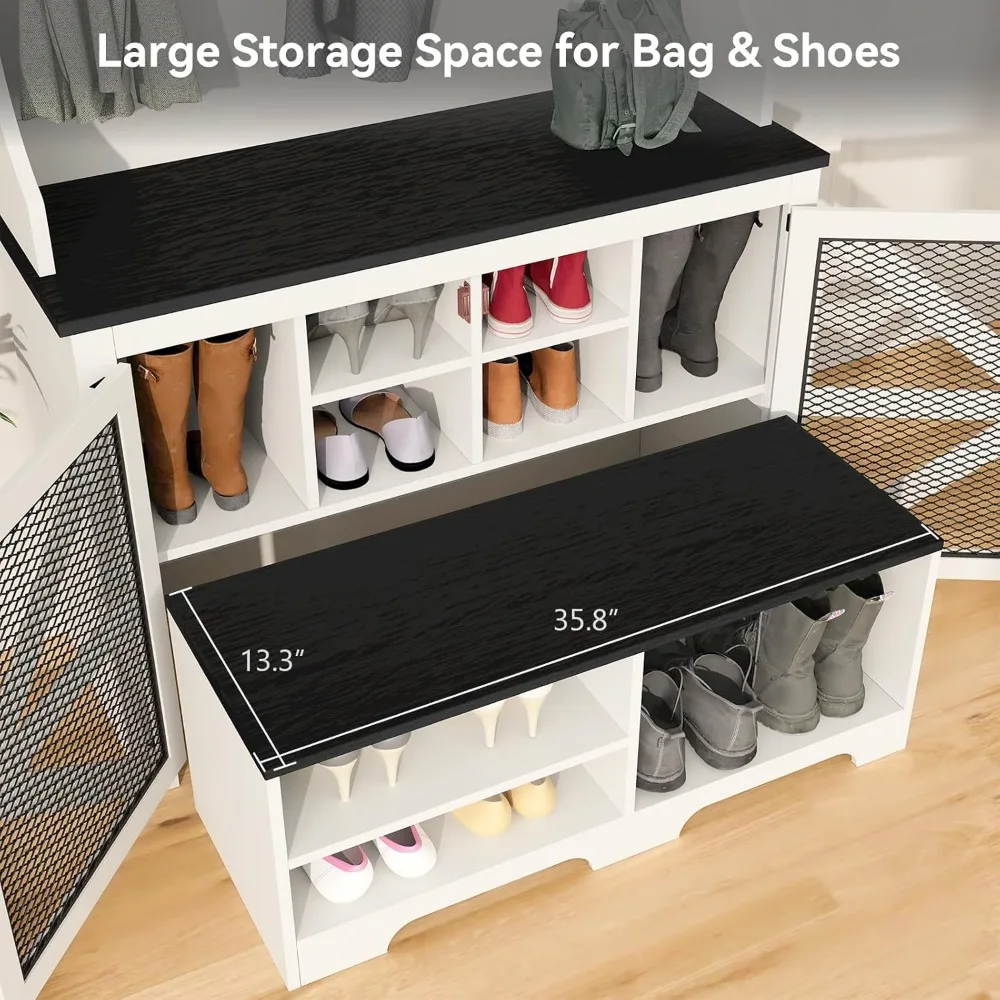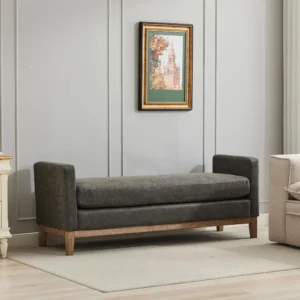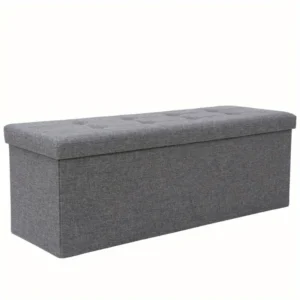Introduction: Transforming Your Narrow Entryway Challenge
Walking into a cramped entryway cluttered with shoes, coats, and miscellaneous items can set a frustrating tone for your entire home experience. That narrow space—often just 4-6 feet wide—becomes a daily battleground where function fights with chaos, and first impressions hang in the balance.
Yet this small area serves as the introduction to your home, the first space guests encounter, and the transition point between outside and inside. A well-organized entryway, no matter how narrow, can transform your daily routine and create a welcoming atmosphere that sets the right tone.
The good news? Even the most challenging narrow entryways can become both functional and stylish with thoughtful organization. By implementing smart decluttering strategies, embracing vertical storage, investing in multi-functional furniture, and making clever design choices, you can maximize every inch of your limited space.
Throughout this guide, we’ll explore practical solutions to help you transform your entryway from a frustrating bottleneck into an organized, welcoming space that meets your needs without sacrificing style.
Essential First Step: Declutter and Assess Your Space
Before purchasing any organizational furniture or accessories, the critical first step is creating a clean slate. Decluttering isn’t just about creating temporary neatness—it’s about honestly evaluating what belongs in your entryway and what doesn’t.
Start by completely emptying your entryway space. This might seem drastic, but it allows you to truly see the area’s potential. As you remove items, sort them into clear categories:
- Keep in entryway: Only daily essentials that truly need quick access
- Store elsewhere: Seasonal items or things used less frequently
- Donate/sell: Items in good condition that no longer serve your needs
- Discard: Damaged items or things that have outlived their usefulness
Be ruthless with your sorting. Most narrow entryways can only accommodate truly essential items. Consider implementing a seasonal rotation system for outerwear and accessories, keeping only current-season items accessible.
With a cleared space, take precise measurements:
* Width and length of available floor space
* Height of walls for potential vertical storage
* Door clearance (ensure doors can open fully)
* Note any architectural features that might present challenges or opportunities
Make a list of the primary functions your entryway needs to serve. Do you need storage for multiple family members? Is mail organization important? Understanding traffic patterns is also crucial—how many people move through this space daily and at what times?
Creating this organizational foundation gives you a clear roadmap for the next steps. The right storage solutions will vary depending on whether you’re organizing a small entryway bench area for a couple or managing a busy family hub.
Maximizing Vertical Space: The Wall as Your Storage Ally
When floor space is limited, the walls become your most valuable organizational asset. Looking upward unlocks storage potential that many homeowners overlook in narrow entryways.
Wall-Mounted Hooks and Racks
Individual hooks or full rack systems provide immediate storage without consuming floor space. Install them at different heights to accommodate adults and children. For maximum functionality, place hooks 5-6 feet from the floor for adult coats and lower options (around 3-4 feet) for children or shorter items.
Floating Shelves
Floating shelves offer display space while providing storage for keys, mail, and small accessories. For narrow entryways, choose shelves with modest depth (6-8 inches) to prevent them from protruding too far into the walkway. Style them with a few decorative items while maintaining most of the surface for practical storage.
Mail Organizers and Key Stations
Wall-mounted mail sorters, key hooks, or small cabinets create dedicated spaces for everyday essentials. These prevent flat surfaces from accumulating clutter and help establish organizational habits.
Over-the-Door Solutions
Don’t overlook the doors themselves as potential storage real estate. Over-the-door hooks, racks, or pocket organizers can hold lightweight items without requiring installation.
When installing any wall-mounted storage, consider these practical factors:
* Weight capacity requirements based on what you’ll store
* Appropriate anchors for your wall type (drywall, plaster, concrete)
* Height placement for easy accessibility
* Maintaining clear pathways and adequate head clearance
The right combination of space-saving entryway ideas and quality bench hooks and storage solutions transforms walls from empty surfaces into organizational powerhouses, keeping essentials visible and accessible while freeing up valuable floor space.
Space-Saving Furniture: Slim, Multi-Functional Solutions
Selecting the right furniture can make or break a narrow entryway. The ideal pieces serve multiple functions while maintaining a slim profile that doesn’t obstruct movement.

When evaluating furniture for your narrow space, consider these criteria:
* Depth under 12 inches for pieces along walkways
* Multi-functionality (two or more purposes)
* Scale appropriate to your specific measurements
* Storage capacity relative to your needs
Narrow Console Tables
A slim console table (10-12 inches deep) provides a landing spot for keys, mail, and decorative items without jutting too far into walkways. Look for options with drawers or shelves beneath for added storage. These work particularly well opposite coat storage in slightly wider entryways.
Storage Benches
A storage bench serves triple duty: seating for putting on shoes, hidden storage for accessories, and a surface for bags or decor. For extremely narrow spaces, perfect benches for narrow entryways typically measure between 24-36 inches wide and 12-15 inches deep, providing functionality without overwhelming the space.
Slim Shoe Cabinets
Vertical shoe cabinets with tilting compartments store footwear efficiently in minimal floor space. These cabinets often have a depth of just 6-8 inches when closed, making them perfect for tight areas while keeping shoes organized and dust-free.
Corner-Optimized Pieces
Don’t overlook corners as valuable real estate. Corner shelving units or triangular tables can utilize otherwise dead space, particularly in entryways with awkward angles.
When placing furniture, maintain a minimum walkway clearance of 36 inches where possible. If your entryway is extremely narrow, prioritize the most essential functions and look for wall-mounted options that provide storage without consuming floor space.
Our collection of narrow entryway benches offers space-conscious solutions specifically designed for tight entryways, combining seating, storage, and style in compact forms that work even in the most challenging spaces.
Strategic Organizational Systems: A Place for Everything
Creating effective organizational systems ensures your narrow entryway remains functional over time. The key is establishing dedicated zones that address specific needs while maintaining an uncluttered appearance.
Create Functional Zones
Drop Zone: Designate a small area—even just a dish or small tray on a narrow surface—specifically for keys, wallets, and phones. This prevents these items from being misplaced and keeps surfaces tidy.
Footwear Station: Limit the number of shoes in your entryway by implementing a “current season, current rotation” rule. A compact shoe rack, cabinet, or designated floor space with defined boundaries keeps footwear contained.
Outerwear Area: Differentiate between daily jackets (accessible on hooks) and occasional outerwear (stored elsewhere). Consider height when installing hooks—frequently used items should be at eye level.
Mail & Paper Management: A small wall-mounted sorter prevents paper clutter from accumulating. Create a simple system: incoming mail, action required, and to be filed/recycled.
Family-Specific Organization: In multi-person households, assign each family member their own hook, bin, or space. Color-coding or labeling makes this system intuitive even for young children.
Practical Organizational Tools
Baskets and Bins: Choose containers that fit your storage spaces exactly, maximizing every inch. Opt for options with lids in open storage areas to conceal visual clutter.
Drawer Dividers: Small compartments in console drawers keep tiny items like keys and sunglasses organized.
Labels: Simple labeling encourages everyone to return items to their designated places.
Tech Solutions: Consider a small charging station to keep devices organized and powered.
The right organizational system makes shoe bench entryway solutions work more efficiently by giving every item a designated home. The key is consistency—items should be returned to their places daily to maintain order in this high-traffic area.
Design Elements That Enhance Space: Light, Color, and Mirrors
Smart design choices can visually expand your narrow entryway while complementing your organizational systems.

Mirror Magic
Mirrors are powerful tools for creating the illusion of space in narrow entryways:
- Position a mirror opposite a light source (window or lighting fixture) to bounce light throughout the space
- Consider full-length mirrors on the end wall of a narrow hallway to visually “extend” the space
- Choose a mirror with a slim frame to maximize reflective surface area
- For dual functionality, look for mirrors with small shelves or hooks attached
Light It Right
Proper lighting transforms how spacious an entryway feels:
- Maximize natural light by keeping window treatments minimal or translucent
- Install wall sconces instead of table lamps to free up surface space
- Consider slim pendant lights in taller entryways
- Choose warm-toned bulbs (2700-3000K) for a welcoming glow
- Ensure the entire entryway is well-lit to prevent dark corners that make spaces feel smaller
Color Considerations
The right color scheme can significantly impact perceived space:
- Light, neutral walls create an airy feeling (whites, soft grays, pale blues)
- Consider the “color drenching” technique—using the same light color on walls, trim, and ceiling—to minimize visual breaks that can make spaces feel chopped up
- If you want visual interest, limit bold colors to one accent wall or accessories
- Glossy or semi-gloss paint finishes reflect more light than matte finishes
Flooring Choices
Flooring plays a crucial role in narrow spaces:
- If using a runner, choose one that nearly fills the width of the space (leaving just 2-3 inches of floor visible on each side)
- Select patterns that draw the eye forward rather than side-to-side
- Ensure flooring is durable enough for high traffic and easy to clean
These design elements work together to create a welcoming entryway that feels more spacious than its actual dimensions. When combined with smart storage solutions, they transform the narrow space from a functional necessity into an inviting introduction to your home.
Solutions for Specific Narrow Entryway Challenges
Every narrow entryway presents unique challenges. Here are targeted solutions for some of the most common scenarios:
Ultra-Narrow Entryways (Under 3 Feet Wide)
When space is extremely limited, prioritize vertical storage and minimal floor-based solutions:
- Wall-mounted folding hooks that can be flattened when not in use
- Ultra-slim shoe cabinets (under 6 inches deep)
- Consider removing doors and replacing with curtains if door swing consumes too much space
- Use ceiling-mounted storage in extreme cases (hanging baskets or pulley systems for seasonal items)
No-Closet Entryways
Without a dedicated storage closet, create your own systems:
- Install a slim wardrobe (12-15 inches deep) if space permits
- Create a “closet wall” with hooks, shelves, and baskets in a coordinated arrangement
- Use a decorative screen to conceal storage areas in open-concept spaces
- Look for furniture pieces that mimic closet functionality, like hall trees with integrated storage
Family-Friendly Organization
Multiple household members require thoughtful systems:
- Assign color-coded hooks or bins for each family member
- Install hooks and storage at varied heights for accessibility
- Create simple systems children can maintain independently
- Implement a “one in, one out” rule for seasonal items to prevent overflow
Awkward Architectural Features
Turn challenges into opportunities:
- Use sloped ceilings for graduated storage (tallest items at the highest point)
- Install shallow shelving in recessed areas or niches
- Consider custom solutions for uniquely shaped spaces
Small entryway benches can be particularly valuable in challenging spaces, as they provide essential seating and storage while conforming to specific spatial constraints. The key is selecting pieces with dimensions that work with—not against—your unique architectural features.
Budget-Friendly Organization: DIY and Affordable Options
Creating an organized narrow entryway doesn’t require expensive custom solutions. Many effective storage systems can be implemented on a modest budget.
DIY Storage Projects
Simple Shelf and Hook Combinations: A basic wooden board mounted with decorative brackets serves as a shelf, with hooks installed underneath for a custom storage wall at a fraction of retail cost.
Repurposed Furniture: Transform a narrow dresser into an entryway console by adding a fresh coat of paint and new hardware. The drawers provide hidden storage for accessories.
Upcycled Door Solutions: An old door laid horizontally and mounted with legs becomes a unique entryway bench, especially when paired with baskets underneath for storage.
DIY Shoe Storage: Create a shoe rack using plastic crates mounted horizontally on the wall, or build a simple wooden rack sized exactly to your space.
Budget-Friendly Purchases
- Look for versatile IKEA hacks that can be customized to your space
- Check secondhand stores for narrow tables that can be repurposed
- Use tension rods and shower curtain hooks in doorways for temporary seasonal storage
- Invest in inexpensive over-the-door organizers for additional storage
Cost-Saving Organization Hacks
- Use command hooks for damage-free hanging on rental properties
- Repurpose kitchen items like mug hooks or utensil holders for entryway organization
- Utilize attractive food containers or baskets as catchalls for small items
- Create fabric shoe pockets that hang flat against the wall
These affordable entryway bench solutions and DIY projects allow you to implement effective organization systems without a significant investment. The most successful budget-friendly approaches focus on maximizing existing features while adding only essential organizational elements.
Entryway Bench with Cushion, Mudroom Bench with Cushion, Shoe Bench for Entryway
$1,186.63 Select options This product has multiple variants. The options may be chosen on the product pageCoat Rack Shoe Bench, Corner Entryway Bench, Corner Hall Tree, Shoe Bench for Entryway
$313.58 Select options This product has multiple variants. The options may be chosen on the product pageEntryway Bench with Back, Modern Entryway Bench, Shoe Bench for Entryway
Price range: $463.13 through $474.44 Select options This product has multiple variants. The options may be chosen on the product pageShoe Storage Bench for Entryway
$459.02 Select options This product has multiple variants. The options may be chosen on the product pageEntryway Bench with Shelf Storage, Shoe Bench for Entryway, Shoe Storage Bench
$194.08 Select options This product has multiple variants. The options may be chosen on the product pageCorner Entryway Bench, Entryway Bench with Cushion, Modern Entryway Bench, Shoe Bench for Entryway
$476.34 Select options This product has multiple variants. The options may be chosen on the product page
Maintaining Your Organized Entryway: Daily Habits and Seasonal Updates
Even the most thoughtfully organized entryway requires consistent maintenance to remain functional. Establishing simple routines prevents clutter from returning and ensures your system continues working effectively.
Daily Habits for Clutter Prevention
The One-Minute Rule: If a task takes less than a minute (hanging up a coat, putting away shoes), do it immediately rather than setting items down “temporarily”
End-of-Day Reset: Take two minutes each evening to return items to their designated places and clear any surface clutter
Mail Processing Station: Sort mail daily, immediately recycling junk mail and placing bills or important documents in their designated spot
Empty Pockets Routine: Empty pockets of receipts and miscellaneous items when removing coats, preventing them from accumulating
Weekly Maintenance Tasks
- Wipe down frequently touched surfaces like doorknobs and light switches
- Return any items that have migrated from other parts of the house
- Sweep or vacuum the entire entryway area
- Check organizational systems and adjust as needed
Seasonal Organization Strategy
- Rotate seasonal items quarterly, storing off-season accessories out of the prime entryway space
- Reassess the functionality of your systems during transitions between seasons
- Deep clean storage containers and refresh organizational systems twice yearly
- Purge unused items during seasonal transitions to prevent accumulation
Creating these simple habits transforms maintenance from an occasional overwhelming project into manageable daily actions that maintain your organized systems effortlessly.
Can a Narrow Entryway Be Stylish While Functional?
The most successful narrow entryways aren’t just organized—they’re designed with intention, balancing practical needs with aesthetic appeal.

Selective Styling
In narrow spaces, the key is choosing fewer but more impactful decorative elements:
- A single statement light fixture that doesn’t protrude into the walkway
- A carefully selected piece of slim wall art or a small gallery arrangement
- Thoughtful paint color or accent wallpaper to add personality
- Textural elements through a runner rug or small accessories
Design Principles for Small Spaces
- Scale: Choose furniture and accessories proportionate to the space
- Visual Weight: Opt for pieces with exposed legs or glass components that feel lighter in the space
- Cohesion: Select a consistent color palette and style throughout the entryway
- Negative Space: Allow for some empty space rather than filling every inch
Functional Can Be Beautiful
The most practical storage solutions can also be the most attractive when carefully selected:
- Choose baskets and bins in materials and colors that complement your home’s aesthetic
- Look for architectural hooks and hardware that serve as decorative elements
- Select organization systems that can be displayed rather than hidden
- Incorporate plants (real or artificial) to add life to the space without consuming floor area
With thoughtful selection, entryway bench storage solutions become design features rather than purely functional items. The most successful narrow entryways embrace their compact dimensions rather than fighting against them, using clever design to create spaces that feel intentional rather than compromised.
Product Recommendations: Tested Solutions for Narrow Entryways
Finding the right furniture and storage solutions for narrow entryways often requires specialized products designed specifically for compact spaces. At Nested Goods, we understand the unique challenges of limited entryway space.
Our collection includes carefully designed pieces that maximize functionality while maintaining a streamlined profile:
Multi-functional Storage Benches: Our narrower bench designs (12-15 inches deep) provide seating and storage without protruding too far into walkways. Many feature hinged tops concealing generous storage space for shoes, accessories, or seasonal items.
Wall Organization Systems: Complete wall systems that combine hooks, shelves, and mail organizers in space-efficient configurations that can be customized to your specific needs.
Slim Console Tables: Our entryway tables feature narrow profiles (10-12 inches deep) with thoughtful storage solutions like drawers, shelves, or hidden compartments.
What sets these solutions apart is their durability. Entryways endure significant daily traffic and handling, so our pieces feature quality materials and construction methods that withstand these demands while maintaining their appearance.
Our shoe storage bench entryway collection specifically addresses the common challenge of footwear organization in narrow spaces, with designs that provide efficient vertical storage while keeping shoes accessible and entryways tidy.
By combining thoughtful organization strategies with quality space-saving furniture, even the narrowest entryway can become a functional, welcoming introduction to your home that reflects your style while serving your daily needs.







